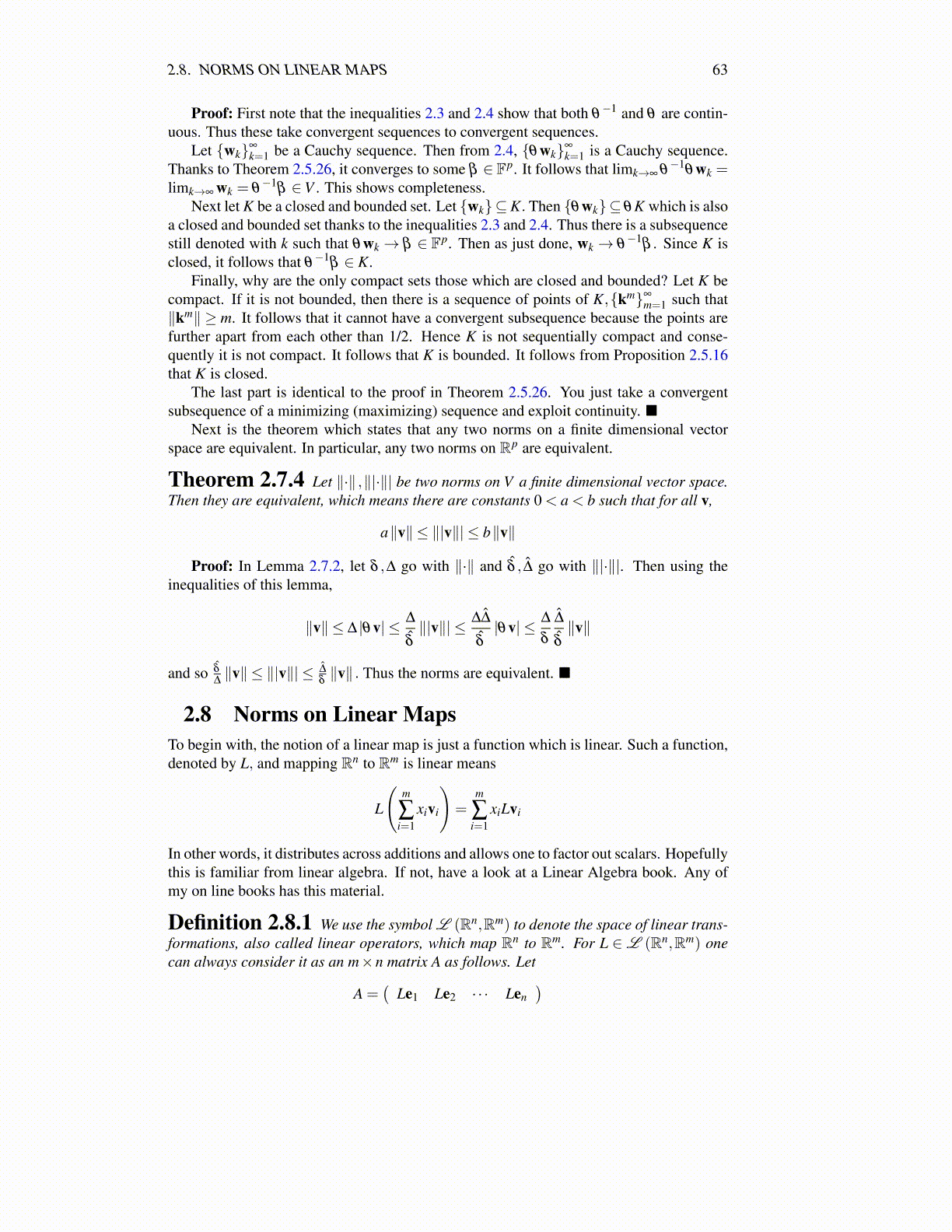
2.8. NORMS ON LINEAR MAPS 63
Proof: First note that the inequalities 2.3 and 2.4 show that both θ−1 and θ are contin-
uous. Thus these take convergent sequences to convergent sequences.Let {wk}∞
k=1 be a Cauchy sequence. Then from 2.4, {θwk}∞
k=1 is a Cauchy sequence.Thanks to Theorem 2.5.26, it converges to some β ∈ Fp. It follows that limk→∞ θ
−1θwk =
limk→∞ wk = θ−1
β ∈V . This shows completeness.Next let K be a closed and bounded set. Let {wk}⊆K. Then {θwk}⊆ θK which is also
a closed and bounded set thanks to the inequalities 2.3 and 2.4. Thus there is a subsequencestill denoted with k such that θwk → β ∈ Fp. Then as just done, wk → θ
−1β . Since K is
closed, it follows that θ−1
β ∈ K.Finally, why are the only compact sets those which are closed and bounded? Let K be
compact. If it is not bounded, then there is a sequence of points of K,{km}∞
m=1 such that∥km∥ ≥ m. It follows that it cannot have a convergent subsequence because the points arefurther apart from each other than 1/2. Hence K is not sequentially compact and conse-quently it is not compact. It follows that K is bounded. It follows from Proposition 2.5.16that K is closed.
The last part is identical to the proof in Theorem 2.5.26. You just take a convergentsubsequence of a minimizing (maximizing) sequence and exploit continuity. ■
Next is the theorem which states that any two norms on a finite dimensional vectorspace are equivalent. In particular, any two norms on Rp are equivalent.
Theorem 2.7.4 Let ∥·∥ ,∥|·∥| be two norms on V a finite dimensional vector space.Then they are equivalent, which means there are constants 0 < a < b such that for all v,
a∥v∥ ≤ ∥|v∥| ≤ b∥v∥
Proof: In Lemma 2.7.2, let δ ,∆ go with ∥·∥ and δ̂ , ∆̂ go with ∥|·∥|. Then using theinequalities of this lemma,
∥v∥ ≤ ∆ |θv| ≤ ∆
δ̂∥|v∥| ≤ ∆∆̂
δ̂|θv| ≤ ∆
δ
∆̂
δ̂∥v∥
and so δ̂
∆∥v∥ ≤ ∥|v∥| ≤ ∆̂
δ∥v∥ . Thus the norms are equivalent. ■
2.8 Norms on Linear MapsTo begin with, the notion of a linear map is just a function which is linear. Such a function,denoted by L, and mapping Rn to Rm is linear means
L
(m
∑i=1
xivi
)=
m
∑i=1
xiLvi
In other words, it distributes across additions and allows one to factor out scalars. Hopefullythis is familiar from linear algebra. If not, have a look at a Linear Algebra book. Any ofmy on line books has this material.
Definition 2.8.1 We use the symbol L (Rn,Rm) to denote the space of linear trans-formations, also called linear operators, which map Rn to Rm. For L ∈L (Rn,Rm) onecan always consider it as an m×n matrix A as follows. Let
A =(
Le1 Le2 · · · Len)